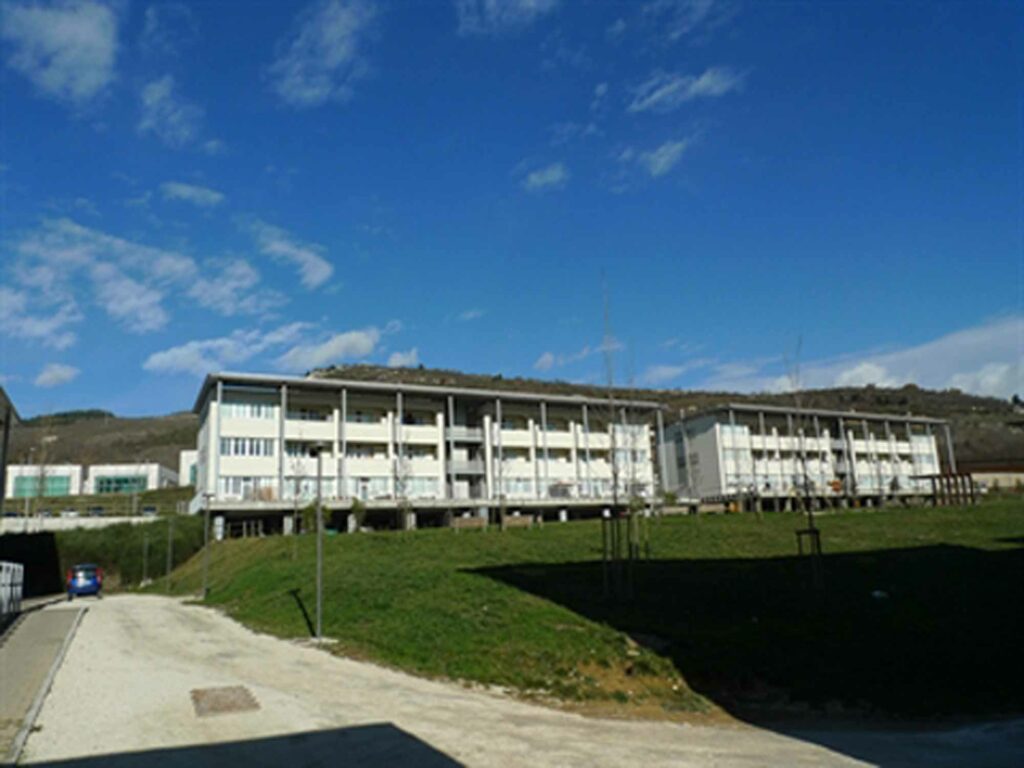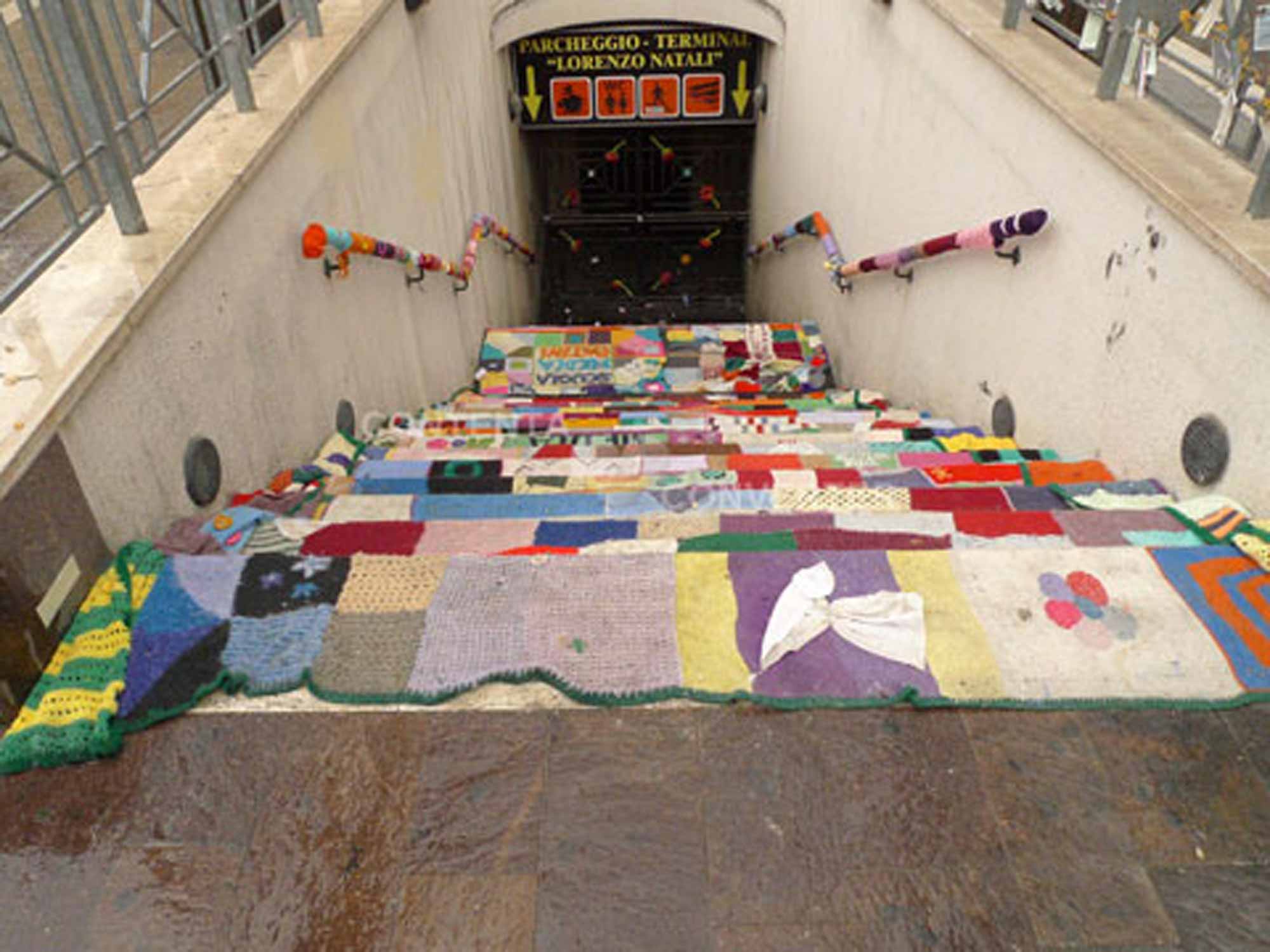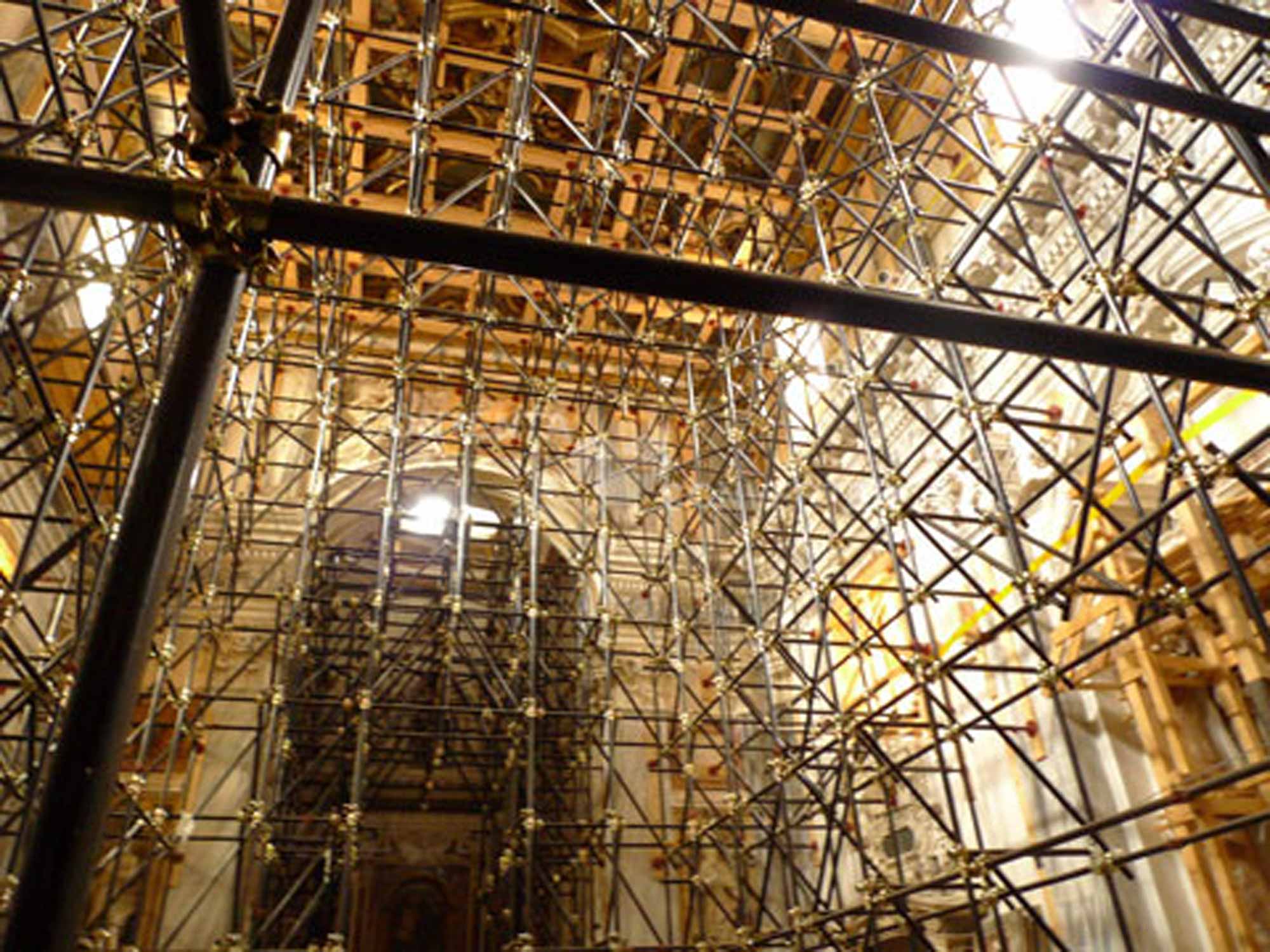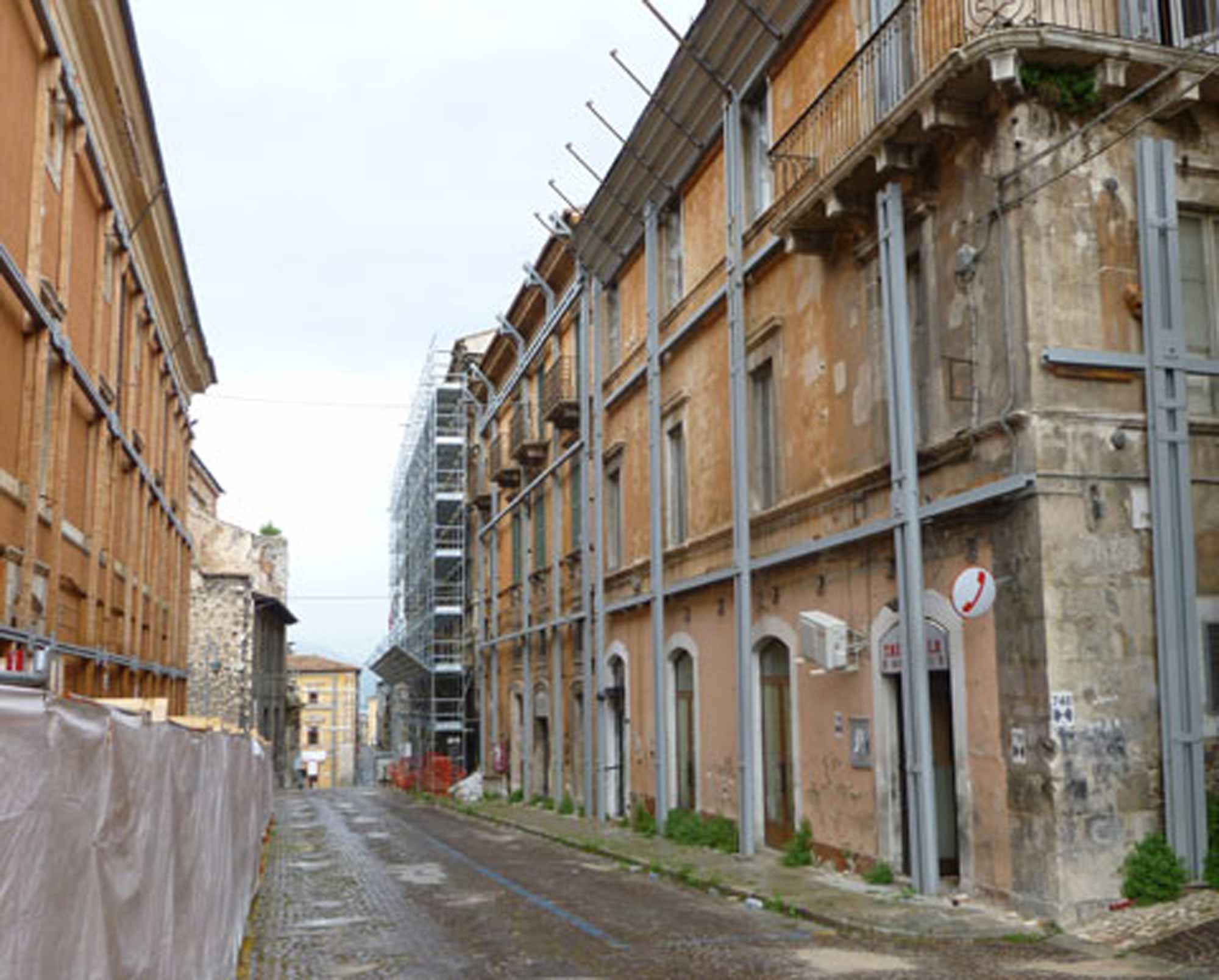by Veit Stratmann
First note
An earthquake shook the city of L’Aquila on the night of April 6, 2009. It killed 308 people and injured at least 2000 others.
Initially, in order to facilitate rescue worker access, any survivors who were able to use their own means to leave the city were asked to do so. About 35,000 people—nearly half the city’s population—left the area. The remaining residents, unable to fend for themselves, were housed in emergency tents set up between 3 to 15 miles outside the city limits.
Gradually these tents were replaced by apartment buildings and single-family homes built in a dispersed manner in the countryside surrounding the city. The construction of scattered housing for the L’Aquila residents was accompanied by an official ban on returning to homes within the L’Aquila city limits. Thus, the city was entirely emptied within hours after the earthquake.
Next, as a prelude to the eventual reconstruction of the city, it was decided that the city buildings should be systematically reinforced by elaborate exoskeletons – either scaffolding or steel beams running from one building to another. These exoskeletons were constructed with such a high degree of complexity and precision, and of such expensive materials, that their building cost alone absorbed the majority of funds set aside to restore the city. In some cases, it now would be less expensive to destroy certain buildings behind the scaffoldings than to deconstruct the supporting structure itself. The exoskeletons literally prevented L’Aquila residents from accessing their own homes resulting in the decision to evacuate the city and to maintain the population at a distance.
To further the organization of the eventual reconstruction of the city, a classification system was supposed to be drawn up in order to prioritize the reconstruction targets. The categories were to include the ranking of buildings in terms of their relevance in art history and of their importance in the visual unity of the city. Other categories were to be centered on structural or city-planning issues. The budget allocations and response time for each restoration were supposed to be based on these categories. However, the description of each category and the criteria for classification were never clearly defined. No money was ever allocated because no buildings were ever formally classified. Hardly any official restoration work has been carried out to date.
The combination of these two decisions—the evacuation of the city and ban on returning to the city — has left the city in a state of suspended animation. The city is physically present and even largely accessible and potentially functional. However, that which bestows sense and form to the city—life and the temporality that life generates — has disappeared.
To walk the streets of L’Aquila is to be constantly faced with the impossibility of synchronizing the temporality of a human being with the surrounding non-temporality. Instead of offering a complementary experience between the person and his or her town, the encounter between a human being and this city creates rupture, incoherence and absence of meaning. The city is no longer a part of things. The inhabitants have become outhabitants.
The geographical dispersion of L’Aquila residents and the ban on returning to pre-earthquake habitations dissolved not only the city’s society but also the city itself. The fact that the city is traditionally and structurally the basic unit of politics in Italy means that the dissolution of the city brings about the annihilation of political space and societal structures. The administrative structures of the city exist, but the space in which they take shape and make sense has disappeared.
If one accepts the premise that politics constitutes, among other things, the art of structuring and sequencing the collective temporality of a society, then the evaporation of L’Aquila’s political sphere and the suspension of time can be considered interdependent and mutually perpetuating. The city is frozen in (or out) of time—and everything is suspended in a motionless state.
As L’Aquila is in a state of suspended animation, much like the absence of molecular movement at 0° Kelvin, its immobility cannot be modified. Any change of status is dependent on the possibility of putting something in motion, but no structure capable of activity exists in L’Aquila. Likewise, the absolute immobility of L’Aquila cannot be objectified but only experienced, because objectifying implies the possibility of measurement. And just as it is impossible to measure 0° Kelvin (because that necessitates the use of an instrument that could be colder than absolute zero itself), the measure of L’Aquila’s immobility would necessitate a tool even less mobile than absolute immobility.
I observe the current situation in L’Aquila much like a rabbit, paralyzed by the sight of a serpent. I cannot look away, nor leave, although I know the danger is great—and this danger risks annihilating my posture as an artist.
I traveled to L’Aquila thinking as an artist. In other words, I assumed that my role as an artist would allow me to formulate questions, to initiate debate and to identify different problems in (hopefully) an appropriate and sufficiently intellectualized manner. However my status as an artist should not permit me to formulate any univocal answers nor to propose any solutions to the non-art-related problems encountered, because any such attempt would completely undermine the pertinence and ethical validity of my artistic action, making it null and void. It would make art disappear.
Once in L’Aquila, I realized (with both horror and fascination) that the current state of things there perfectly materializes certain notions that I ponder in my own work: breaches of meaning, porous borders, the blurring of statuses, the posture of the spectator, the individual as a responsible being, who assumes his choices and takes can take a stance.
The fact that L’Aquila has fallen out of time and out of context generates a void or black hole. This non-L’Aquila sucks all meaning out of the surrounding environment. The city is that gigantic rupture of coherence that I try to capture and construct in each of my pieces.
On one hand, I had to be interested by L’Aquila. To be disinterested in L’Aquila would deprive me of a vast treasure trove of data relative to my work. It would deprive me of a physical and mental journey to the core of a space that represents the basic foundations of my work. It would deprive me of the exploration of the materialization of the driving force that maintains my artistic action.
On the other hand, L’Aquila is in an unacceptable state. And this status calls for real change. It appeals to the formulation of an objective—something that I feel should be avoided in an artistic posture. The necessity of identifying a goal runs the risk of transforming anything that I might accomplish in L’Aquila into social work, canalizing my thinking towards a univocal solution to purely non-art related problems. Art runs the risk of disappearing by its mere presence. And this risk is all the greater in the absence of any societal or historical structures, for the introduction of an artwork in L’Aquila would confer a special status to the work, underlining it as the only thing with a clear meaning and structure. Art would run the risk of filling the void left by the absent social structures and of self-effacing in its own presence.
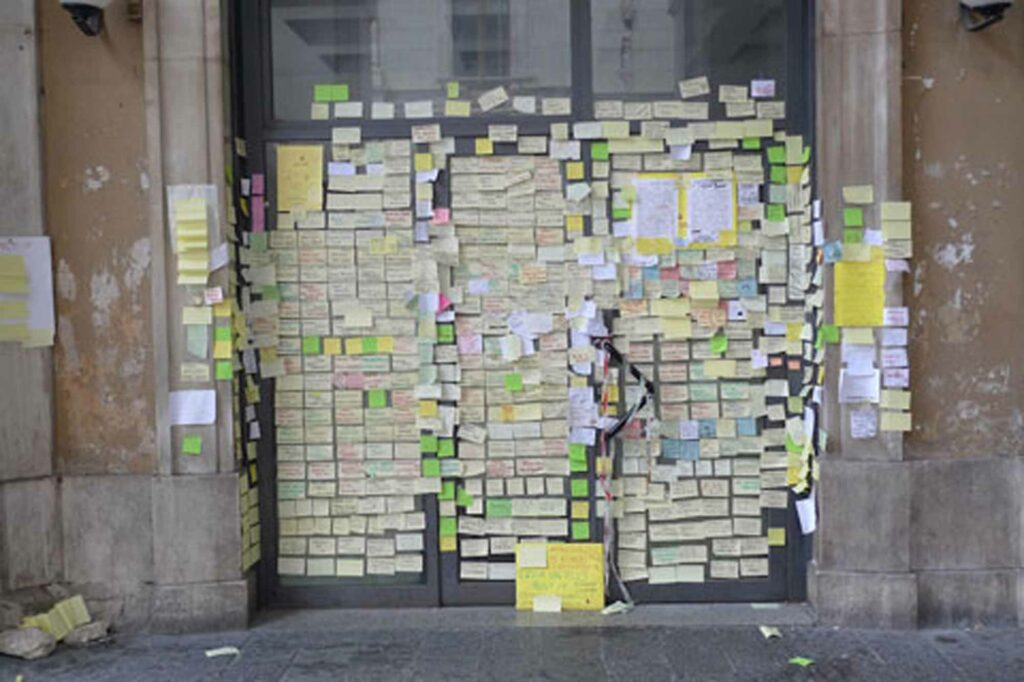
My hesitation was reinforced as I walked the streets of L’Aquila. I had the overwhelming sensation of being in temporal desynchronization as a living being, faced with the surrounding structures in their out-of-time zone. I felt my inability to integrate myself as a social being in this context, which was bereft of any coherence, of any structures or of any frames of reference. These impossibilities—and the ruptures of sense they created—intrigued me so much that I could not resist wanting to do something.
I could attempt to fill the void. However, this first approach would lead me to propose a solution. Or I could attempt to pressure the fault lines to their cracking point and explode the status quo. In this case, I might be able to propose an artistically appropriate gesture. However, this second approach would be extremely difficult to defend from an ethical point of view, given the specific case of L’Aquila and the additional suffering that might be caused to innocent people. In either case, the impact of any work placed in L’Aquila would be rendered null and void in the absence of a public.
The only possible approach in order to infiltrate the situation seemed to begin with the de-dramatization of the relevant vocabulary: I needed to transform the notions of artwork and artistic action into the simple word gesture. This term designates nothing other than the idea that an artist – which I am – makes and produces forms. This term is sufficiently vague that it can be used in connection with L’Aquila without being taken for an attempt at a social or political solution, without it conveying the notion of being in contradiction with the current situation or constituting itself as a potential corrective agent.
I decided that I should carry out my gesture with intense discretion by documenting what I saw, writing in order to outline the stakes and to reinstate the results of my observation. For now, I have two words with which I can work: gesture and artist. I need to create a tension and interaction between the two. I find myself in an insoluble situation, much like Chuck Jones’ iconic Wile E. Coyote, legs churning and suspended in mid-air above the gaping canyon with the elusive roadrunner just out of reach. Yet this impossible posture seems the only viable approach.
Second note
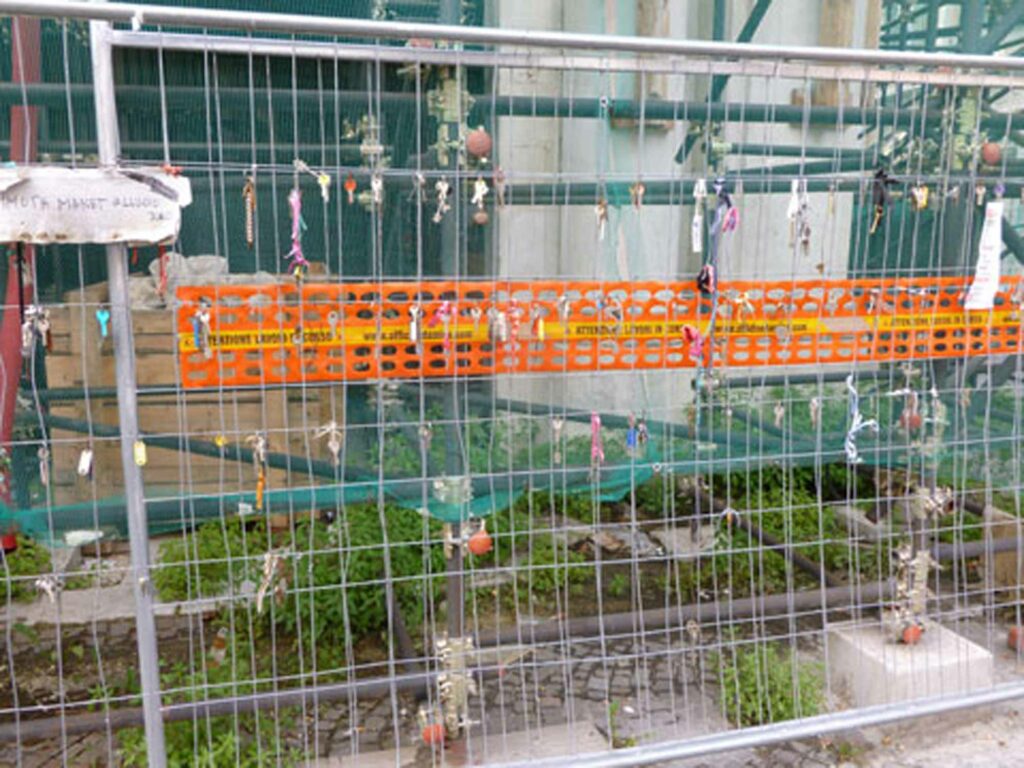
1. The freezing of time and the dissolution of political space, which took place in the aftermath of the earthquake in L’Aquila on April 6th 2009, transformed the city into a non-lieu. A gaping black hole opened up where the city once was. And that black hole aspirated the meaning and purpose of the city, absorbing any notions of coherence, organization or social structure. As society itself was aspirated, all that is left is a carcass – of urban, architectural and security structures – devoid of life and disconnected from normal temporality. L’Aquila is no longer. All that remains is a un-city (I use the expression un-city in echo of the German word for vampires and zombies, Untote, which means the not-dead).
An artistic gesture carried out in this un-city would become the only structure capable of indicating the presence of life in a lifeless environment. It would be the only apparatus capable of underlining the passage of time in this city that has fallen out of time. The artistic gesture would echo the traces of life and societal structures. Effectively, it would become their replacement. But, by its very nature, an artistic gesture cannot replace something and this condition of replacement would annihilate any possibility of the artistic gesture actually being art.
In other words, any artistic gesture introduced in the un-city of L’Aquila is stuck in an indissoluble and paralyzing contradiction. As art, it is alive – or at least a trace of life. Yet in the un-city, it is lifeless and devoid of justification, dead. Art in L’Aquila would, like the city itself, become a zombie.
2. Not being able to avoid this reasoning, I began to accept that the two words that I chose as a starting point, gesture and artist, needed rethinking because linking them together made them seem pointless in the zombie-like zone of L’Aquila.
Yet the status of this un-city continues to fascinate me, and I feel that I need to keep trying to DO something. I realize that I need to dissolve the link between the terms gesture and art and then link each word separately to the un-city itself. The initial duality becomes a triangulation composed of gesture, art and un-city.
A triangulation does not allow for an artistic gesture in L’Aquila, but it does allow me to differentiate and modulate the relationships between the different components. This triangulation allows me to play with the various starting point combinations and their manifest or tacit presence. At least I can act.
3. For the moment, there seem to be two paths of modulation and potential action:
On one hand, I can carry out an action – make a gesture – in the urban and architectural carcass of the city, specifically in what was its public space. However this gesture must be plausible in its environment. The question of its artistic origin should not be posed.
On the other hand, I can carry out an action that is fully inscribed in the realm of art. However this gesture cannot be carried out in the city’s public spaces due to my issues with responding to L’Aquila’s current state by making art about it.
4. Even if these two possibilities are functionally opposite they are linked by an underlying condition. Neither possibility can be productive if it is capable of contradicting its surrounding or of constituting a corrective element:
– If an action carried out in the public space of L’Aquila has the capacity of correcting or contradicting the surrounding situation then it becomes extraordinary (perhaps even a work of art). It will then lose plausibility.
– If an action carried out outside L’Aquila has the capacity of correcting or contradicting the situation from a distance then it becomes a proposal for solving non-art related problems and loses its status of artwork. It will likewise be nullified.
My current possibilities for action seem to only be potentially productive if they are exclusively attached to the materiality of the city, measuring that which is quantifiable. At the same time, I can operate on the principle that in measuring, my potential actions delimit the field of possibilities and create forms. If these forms are based on measurement, they have a function and cannot be completely devoid of meaning. But this meaning appears, in given context of cause and effect, as a byproduct or a parasitical phenomenon. The notion of meaning as parasite may indeed have its place in the un-city of L’Aquila. It may even be plausible in its environment.
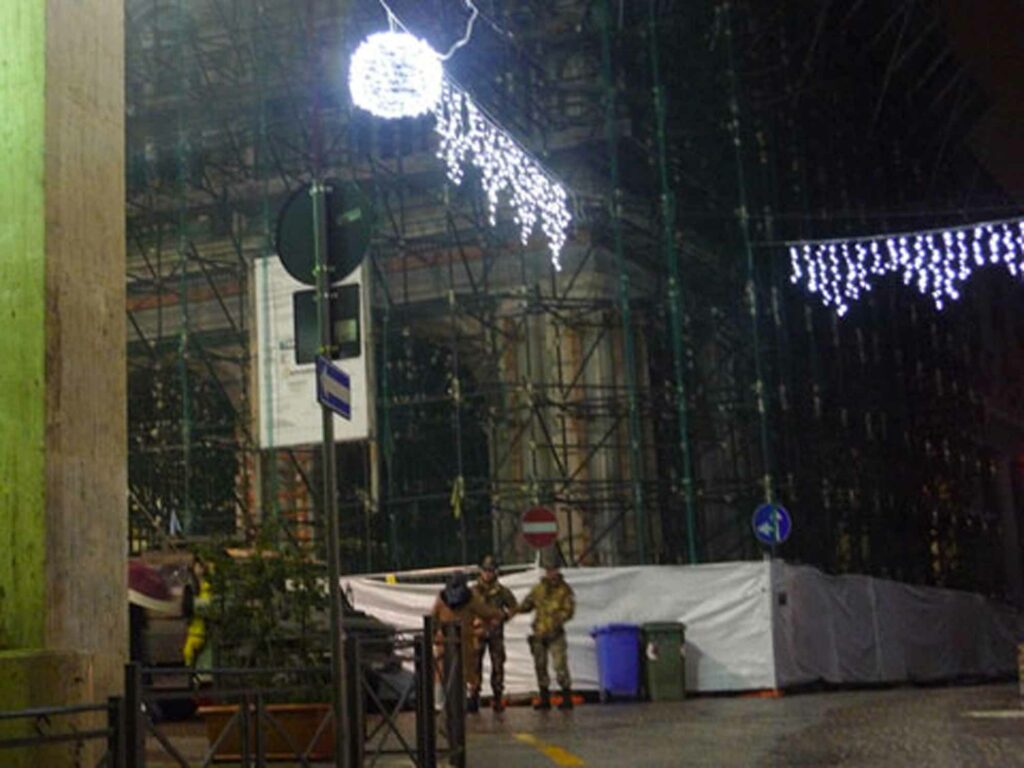
Third note
A people counter
Some premises
An artistic gesture in L’Aquila cannot be oriented around its potential public reception – for there is no public. It cannot, therefore, be construed as an artwork, which draws upon the fact of being out of the ordinary. This artistic gesture can neither formulate questions nor constitute a proposal because there is no one on the receiving end of such an invitation, nobody to take any questioning into consideration.
An artistic gesture in L’Aquila can only be effective if it is stripped of the privilege of being considered artwork and becomes autonomous, inventing a functional objective in the city (which may or may not be taken into account).
In order to be efficient, an artistic gesture carried out in L’Aquila should be both discrete and plausible within its environment. Its artistic origins should never come into question.
The functionality of such a gesture cannot target an improvement of the situation in L’Aquila because that again would suggest the taking into account of information disseminated by the work by a given public. An artistic gesture in L’Aquila should integrate the part of the city that was the most densely populated of the city. In this way, the work can take shape not in the sculptural, self-contained sense but within the materiality of the city itself. In being limited to the materiality of the city itself, the work can be detached from the amorphous societal structure of L’Aquila and avoid becoming extraordinary.
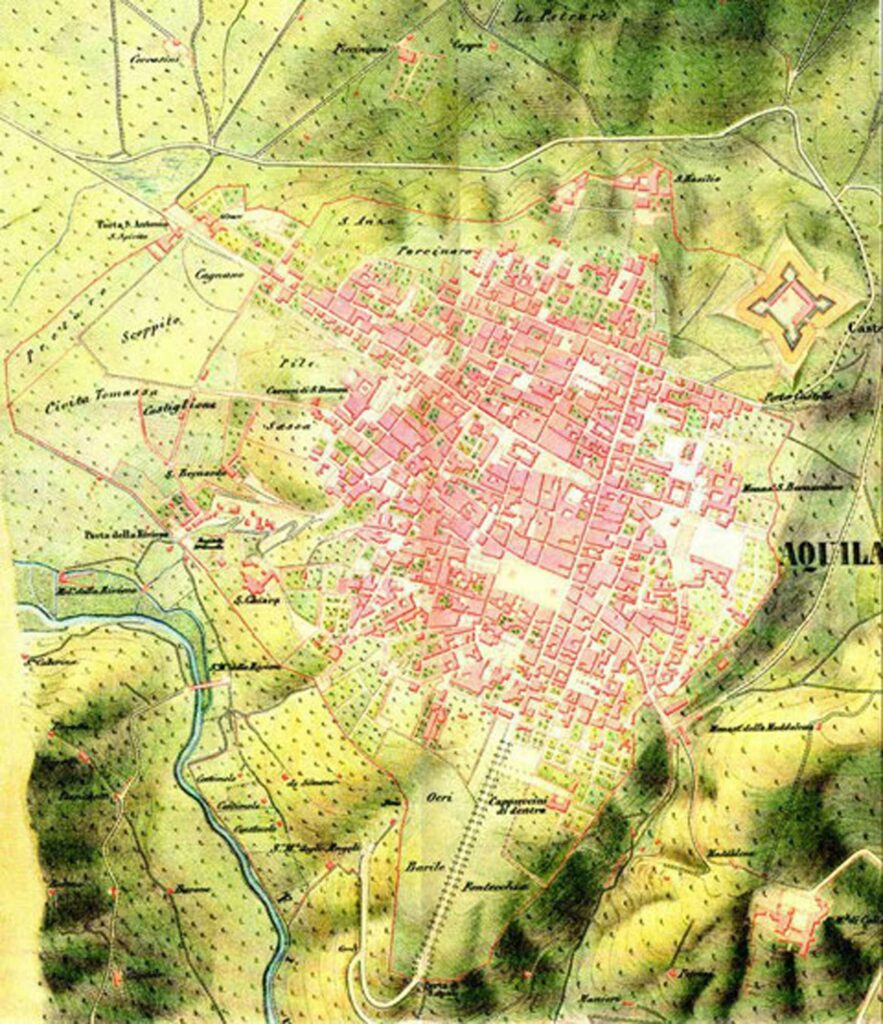
Description
Double photoelectric barriers will be installed at each of the 70 entrance points to the core zone of L’Aquila. This was the most densely populated area of the city before the 2009 earthquake. The frequency and the direction in which the infrared beams forming the barriers are interrupted will allow the number of by-passers entering and exiting the city to be counted. The number of people within the given zone will be accounted for at all times.
The photoelectric barriers will be installed at a height of 120 cm (approx. 4 ft.) off the ground to avoid counting wild animals (especially stray dogs, which are extremely numerous in the old city center). With similar logistical reasoning, the barriers will be installed at intervals of 150 cm (approx. 5 ft.) in order to distinguish between people moving in cars and pedestrians. A person on foot cannot span the same distance as a moving car and therefore he can only block one sensor at a time whereas a car can block two simultaneously. Since car circulation in the city center is nearly exclusively that of official vehicles (police or army) carrying two passengers, moving cars will be counted as including 2 people per car.
A display screen indicating the number of people present in the delimitated area in real time will be placed in the delimitated zone in the Gazebo, a structure made of glass and wood that served as an annex to the Dolce Vita bakery. This building is located in front of the old Hotel Sole on the corner of a little square formed by the intersections of Pizzo Doca, San Crisante and Tre Maria streets. The display screen is to be situated on this particular building because of its transparent structure and its familiarity to the public. However the building will not add any symbolic layer to the project. Because the Gazebo is at a significant distance from Corso Vittorio Emanuele, the main street of the historic city center, its non-central location serves to diminish the importance of the installation.
The People Counter’s small size and location may thus be perfectly ignored. Furthermore, the display screen and photoelectric barriers the people counters/motion sensors only quantify a marginal aspect of the city. They do not intrinsically modify L’Aquila nor constitute any inherent potential of influencing the current situation there. And in referencing a purely material reality, the People Counter remains detached from the now shapeless society that surrounds it.
Nothing indicates the origins of the People Counter. It is simply there, without any commentary. This is the only way in which it can avoid taking an extraordinary status. Because the information provided by the People Counter remains factual, the installation can slip, without resistance, into the non-system of l’Aquila.
2. Because of the decentralized location of the Gazebo, the People Counter can go completely unnoticed and unread. To read the screen, two choices are necessary. A decision to enter the delimited zone and leave the main streets to reach the site of the Gazebo must be made. Then another decision has to be made to stay for some time in front of the display screen, observing the changing numbers. If choice-making can be considered the basis for political action, then reaching the site of the People Counter and taking the time to watch the display represent decisions and actions that could result in the first embryonic step towards making political gestures in L’Aquila, creating the seeds of politics itself.
The People Counter is neither oriented towards the collectivity nor towards an individual. It simply records the presence of individuals within a given area. Yet, because of its location, each individual who takes the People Counter display into consideration automatically constitutes himself as a group member within the designated zone. Each individual who stops to watch the People Counter triggers – at least temporarily – the emergence of the nucleus of a society.
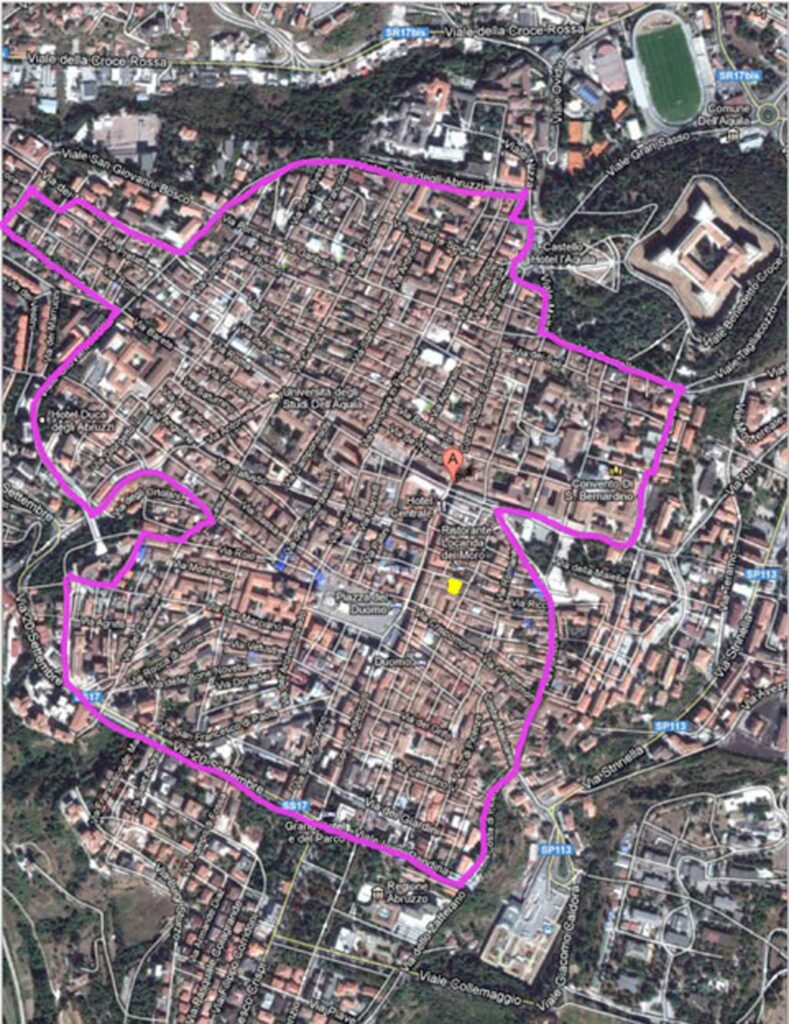
Forth Note
Remarks on Empty Images
On 6th April 2009, an earthquake rocked the city of L’Aquila in the Abruzzi. Three hundred eight people were killed and over 2000 wounded. To facilitate rescue operations in the immediate aftermath of the earthquake, any survivors who were financially or logistically (having another place to stay) able to leave the city using their own means were asked to do so. About 35,000 people – nearly half the city’s population – left the area.
Those residents unable to leave by their own means were housed in temporary camps set up between 3 to 15 miles outside the city limits. As a security measure – given the impossibility of ascertaining the precise physical damage to each building – and as a prelude to the eventual reconstruction of the city, buildings were systematically reinforced by elaborate exoskeletons – either scaffolding or steel beams running from one building to another. These exoskeletons were constructed with such a high degree of complexity and precision and of such expensive materials that their building cost alone absorbed the majority of funds set aside to restore the city.
Due to uncertainty surrounding the structural status of each building in the city, a ban on citizens returning to live in their homes the city was imposed. This ban was meant to be temporary yet it is still in effect. Indeed, it very quickly became evident that the exile of the inhabitants of L’Aquila would last for a long time as the city reconstruction funds were dilapidated by the construction of exoskeleton scaffolding before any construction could take place.
Next, the Berlusconi government proposed to rebuild the city centre on an empty lot near the city center. When the L’Aquila city council refused this proposal late in the year, the temporary camps suddenly became a housing crisis as lodgers were faced with the encroaching winter and no plans to rebuild. Large plots of land were hastily acquired for construction. The sole criterion for the acquisition of these plots was immediate availability. The cost of the plots was irrelevant. Thus the location of the various construction sites for new neighbourhoods was the result of completely random purchases, with no urban coherence or interconnection of the sites.
Once the construction sites had been purchased, a call for tender was issued for the development planning and the deployment of anti-seismic construction systems. However, the decision-making process and the contract award procedures were not entrusted to local or regional authorities but rather to the Italian national central administration. This administrative entity chose to concentrate on a single aspect of the tenders, the anti-seismic construction systems. In the end, they chose the most expensive – but not necessarily the most effective – system. With the decision-making taking place far from L’Aquila and the focalisation on the anti-seismic question, the pragmatic side of building homes was relegated to a low priority. The cost of anti-seismic construction – and of building new housing – absorbed the rest of the money allocated for city reconstruction. The temporary housing became permanent edifices grounded nonetheless in the provisory. A series of temporary-permanent structures and spaces sprang up around L’Aquila in a network of spatial-temporal interstices. It was apparent that these structures would be around for a long period of time yet they did not encourage settlement and appropriation of vital space.
1.2 The incoherence of the decision-making behind the construction of these semi-permanent dormitories which have no link to the urban structure of L’Aquila – or to the surrounding countryside – prompted the authorities to attempt to justify their construction. They came up with the acronym of C.A.S.E. (Costruzioni Anti-Sismiche e Ecocompatibili or Anti-Seismic Eco-friendly Constructions), which echoes the Italian word for houses (case). Without ever officially abandoning the idea of temporary this acronym attributed stability and an excuse for durability to the new housing projects. By definition, these structures became superior to the old buildings of the city center, which in no way could be considered as anti-seismic or eco-friendly constructions within the recently designated architectural standards. Because the notions of anti-seismic and eco-friendly did not exist when the buildings were constructed, the authorities imply that they are inferior to the C.A.S.E. The acronym instilled a positive connotation to permanency: to live permanently in an eco-friendly home was an act of responsibility – and legitimized the permanency of the temporal interstices around L’Aquila.
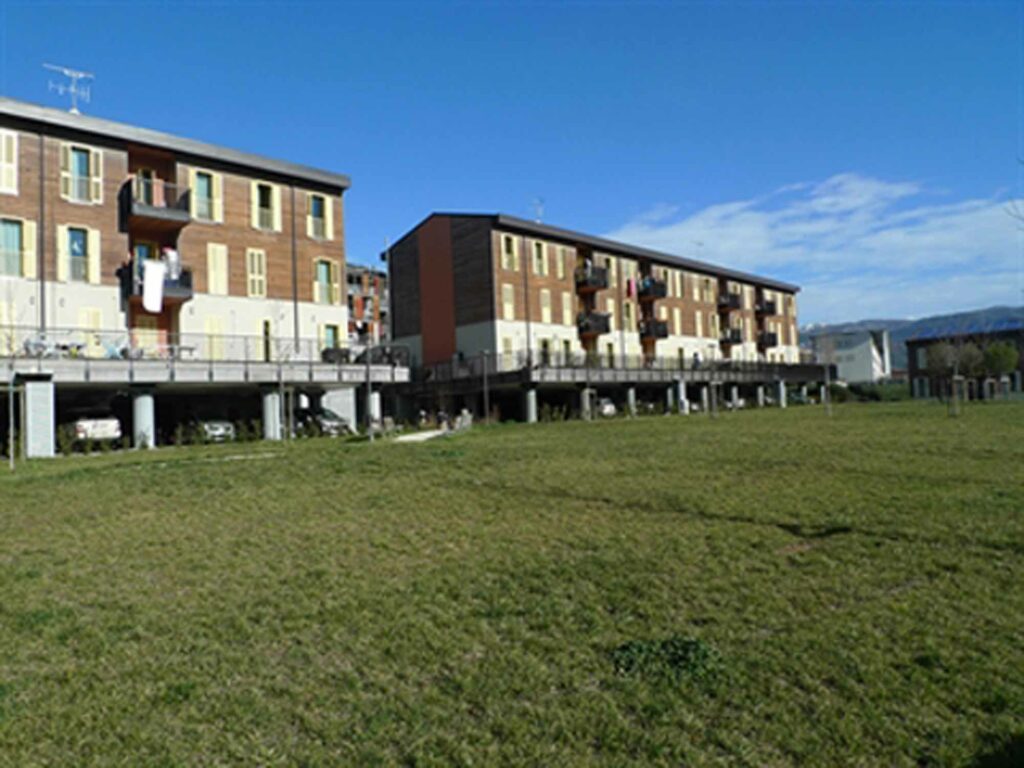
A single figure can be found in all discourse concerning the C.A.S.E.: 30 years. This number is cited each time the rebuilding of L’Aquila and the subsequent duration of the housing projects are discussed. But thirty years also constitutes a generation. With this timeframe any urban planning project becomes null and void. The C.A.S.E. slid out of any timeframe.
2.1 The Città is the core of Italian politics and society. The evacuation of L’Aquila meant the destruction of the political space and the social structures of the city. The construction of the C.A.S.E. and their random implantation on the outskirts of L’Aquila transformed the annihilation of social structures into a landscaping principle that the inhabitants of L’Aquila cannot escape.
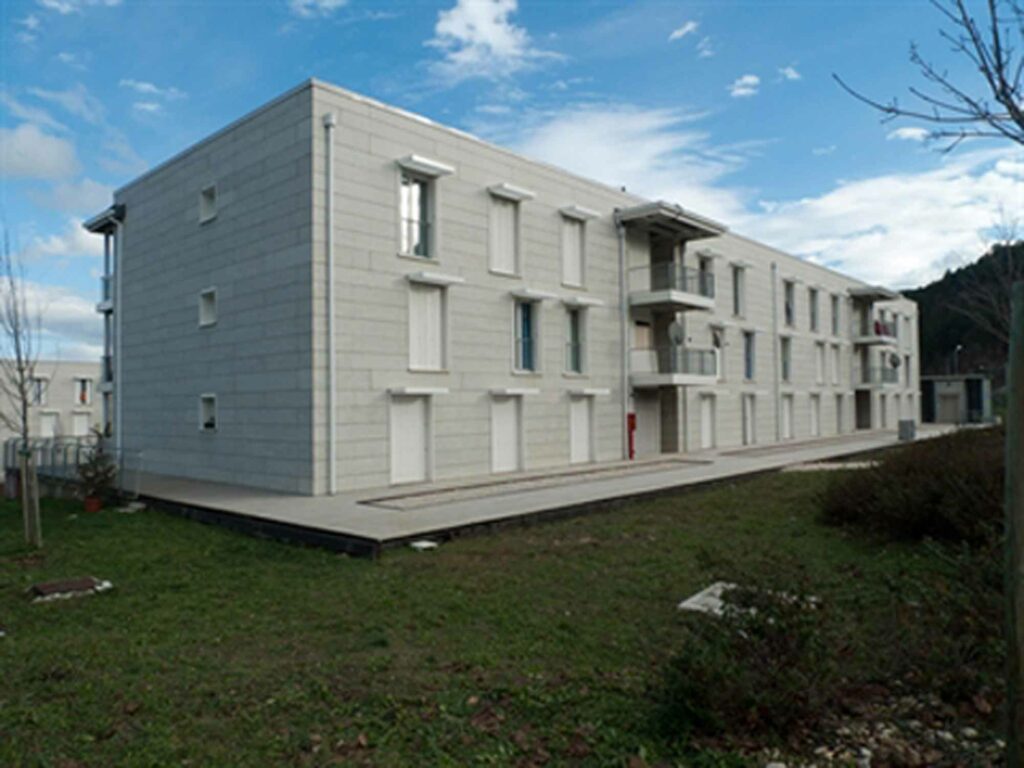
2.2 At the same time, within the C.A.S.E., no social structures – stores, restaurants, medical centres, or recreational facilities – have been built. Thus, the annihilation of society, the dissolution of social interaction and the impossibility of developing a social identity in relation to one’s surroundings have become the structuring vectors of the C.A.S.E.
The C.A.S.E. are devoid of political and social spaces. Furthermore, no public transportation links the C.A.S.E. sites nor connect these sites with the city. Cars are the sole form of transportation linking the C.A.S.E. to the world outside. Yet, for the most part, the demographic composition of the C.A.S.E population is overwhelmingly elderly people who never drove or who can no longer drive a car. Thus, the residents of the C.A.S.E. rarely leave their lodgings. Despite their high occupancy rate, the C.A.S.E appear uninhabited and social interaction is rarely seen. The C.A.S.E. have not only slid out of the framework of temporal normalcy but they are also beyond the reach of political and social space.
3.1 I discovered the C.A.S.E. during my second trip to L’Aquila in December 2012. I had already visited L’Aquila but I had only seen the old city. On my second trip, I was travelling with an architect and urban planner, who was specifically interested in documenting the CASE. To pass my time, I took some photos, too.
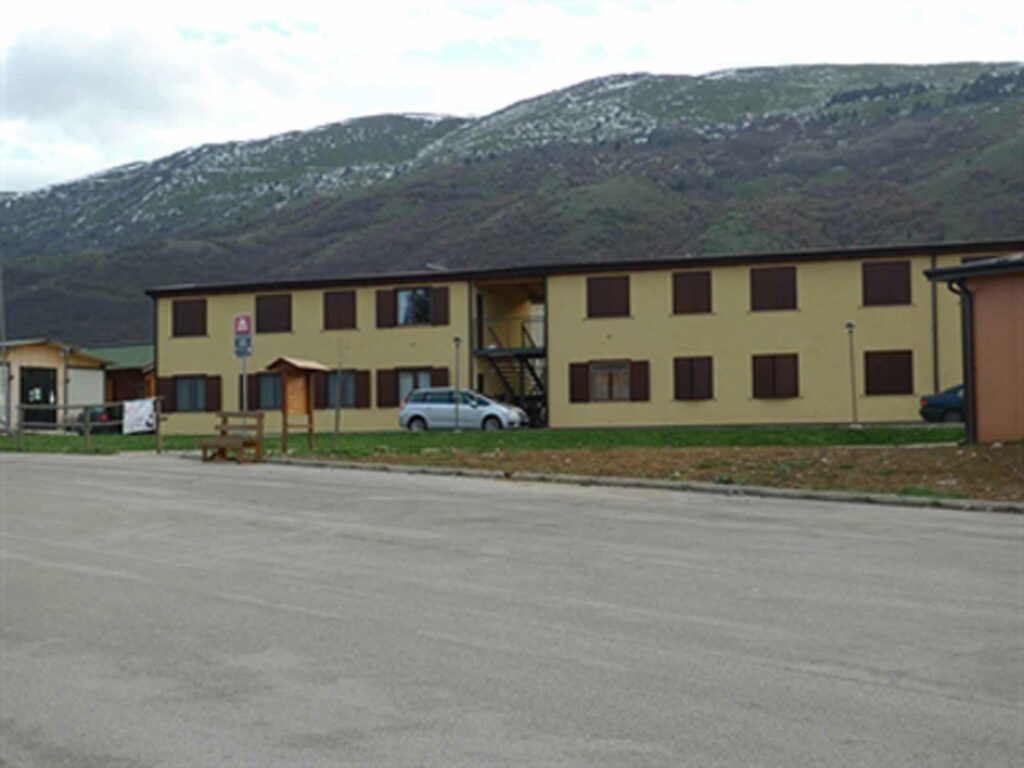
What astonished me during my tour of the C.A.S.E. was the total absence of any visual or aesthetic impact. Despite their physical presence, the C.A.S.E seemed absent. I could of course look at them but I could not really see them nor contemplate them as one might contemplate a form. In the book Beetle in the Anthill by Arkady and Boris Strugatsky (1980), the wanderers are a people who can fold-up and disappear in the face of danger. The C.A.S.E. seem to fold upon themselves and disappear in the same manner.
3.2 Later, when I looked at the photos I had taken, I was astonished to see that they looked completely empty. I had the feeling I could see nothing even though they contained ample visual information. The images, like the C.A.S.E. disappeared within themselves as though aspirated into their self-produced void. I was even more surprised that this retraction of the images seemed to spread to the surrounding environment. It, too, seemed to be sucked into the same void.
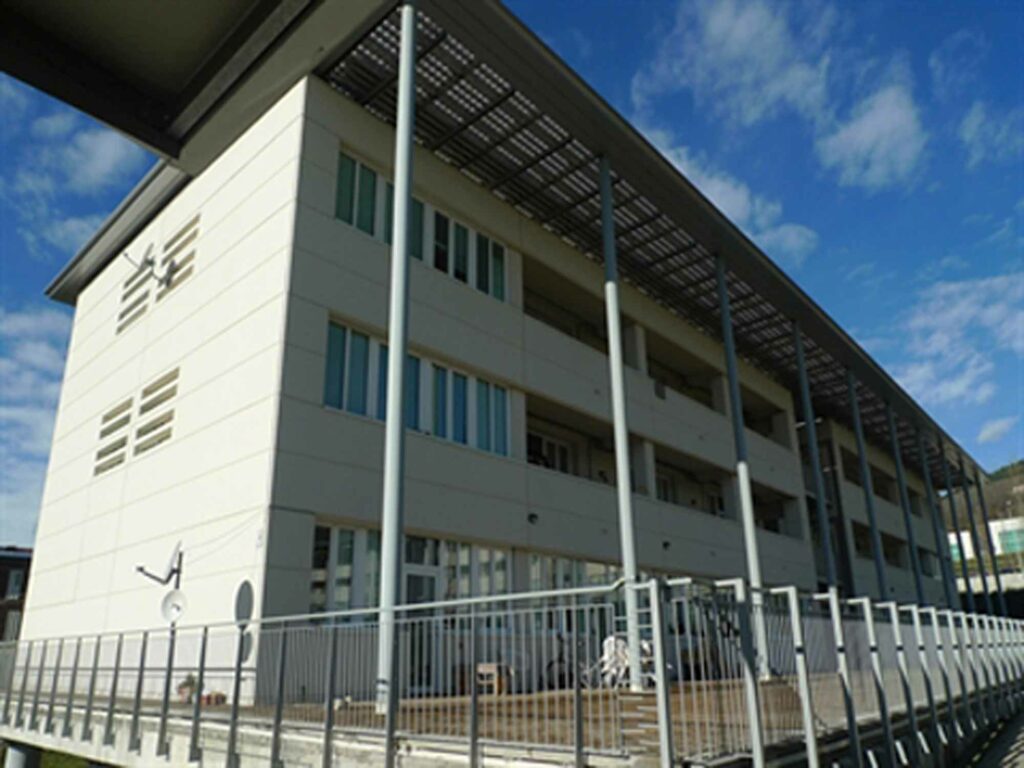
4.It is very likely that the visual vacuity I witnessed was the direct result of my ambiguous status in relation to the C.A.S.E. I had not initially intended to study them in my initial reflections and my work on L’Aquila. But once I was there and had taken their presence into consideration it was impossible not to photograph them. The strange dissolving of coherence and slowing-down of time produced by the C.A.S.E. proved too fascinating for me to resist the opportunity to photograph them. Yet I had to remind myself that the point of photographing the C.A.S.E was to document the situation and not a question of morbid fascination. I wanted to avoid a voyeuristic approach.
The superposition of two incompatible approaches – voyeuristic fascination and documentary-style detachment – may have been what neutralised the images at the moment they were taken. It is likewise possible that the C.A.S.E. do indeed create a visual void, absorbing any regard posed upon them like a black hole absorbing light, allowing nothing to escape. Perhaps the photos of the C.A.S.E. are simply desperately empty non-images. Or perhaps the C.A.S.E images absorb the spectator’s gaze. They are empty because they should not be seen.
